Let's Go Outside
looking through windows to the world
View from the Artist's Window, Alice Neel (1978)
A new art teacher arrived for my last few years of school. He was freshly graduated, and his personality was somehow both deeply engaged with the possibilities of art education, and drily detached from the actual students he was teaching. You couldn’t ask for a better mix for a teenager, really, prompting us to delve further into his teaching in the hope we might one day understand his depths, if not emulate them. I recall more from him in those few years than almost anything else from that otherwise exhausted school, but the most enduring lesson was also the simplest: fill your frame.
When he arrived, he found a class, and probably a school, addicted to absence. A white sheet of A3 drawing paper, and in the middle, swimming in absence, a seashell, a toy car, a sheep’s skull. In our second drawing lesson, he made us cut a little viewfinder from the centre of a small piece of paper. The hole was no bigger than an old photographic slide. “Hold that over your object,” he told us. “Now that is what you will draw. Fill your paper to the edges with what’s inside that little rectangle.” From there, all the elements of representation followed, years too late but not too late. Negative space, form, shadow, observation of what really is: all the essential elements of creating an image replaced our nervy, neurotic desires to reproduce a realistic avatar of the thing. You were no longer trying to accurately recreate the sheep’s skull in graphite or ink: instead you saw the texture of bone, the curve of the socket, and so on. The thing you wanted to represent became an afterthought to the shape and space and tone of what you put on the paper.
I thought about him this morning. As I arrived to my office, unable to settle, I looked out of the window at the square below, and decided to sketch the leaves of the tall palm tree that sits at eye level directly from my desk. They are framed by my window, and they frame the windows behind them, and as I sketched, I drew this beautiful and enormous palm right in the centre of my page, a thumbprint, adrift again in the sea of paper. I stared at the window frame, its peeling brown paint in the August morning sun, and I stared at my phone, a rectangle cut out in black, and I stared at square, the tourists taking a morning coffee, the parched, waterless fountain. I wanted to put a frame around my day, to clip this particular view, half sky, ranks of shuttered windows, tops of trees, like the painter Alice Neel, whose windows frame the New York streets just so. Neel cut and clipped the same view again and again as a series of shapes and colours that are somehow different every time. She painted from her home, and the window of the home frames a terse dynamic between the domestic space and the public, filled with both a desire to have both at once, whilst resenting the presence of both.
107th and Broadway, Alice Neel (1976)
Across the square from my office lives another artistic legend, Nazario Luque, a cartoonist, painter and photographer who, time and again, has used the square as his paper and his window as the frame. I’m not going too far when I say I’m becoming obsessed with Nazario. I discovered him on the recommendation of a friend, and bought a copy of one of his comics. When I tell you it was called Ali Baba y Los 40 Maricones — Ali Baba and the 40 Faggots — you’ll begin to understand why. His work is joyously perverse, a cross between Robert Crumb, Tom of Finland, Donelan, John Waters and Giles, featuring queer retellings of tales from antiquity like that of Salomé through to his post-Francoist transvestite detective Anarcoma.
One of the many things I love about Nazario’s work is its erotic intimacy; his stories, like Ali Baba, are often focused on the locus of the homosexual’s apartment as a place of pleasure and friendship. Recurrent in his work, especially, are the gaps at which the sensuous internal — let’s say, his boudoir theme — meets the possibilities of the external — the cruisy street. Windows, balconies, terraces and doors litter his pages, from where his characters can watch each other posing provocatively, their desire framed discreetly yet broadcast out. They are the fantasies of a voyeur (the artist has described himself as such), and maintain that combination of over-aestheticisation and introversion that all good voyeurs hold within theirselves. Take this wonderful double-page spread (above and below) depicting a siesta across an alleyway. In the first apartment, the artist relaxes with a coffee, a full stomach, and the peelings of his orange at his lunch table. One lover, pants unzipped, takes his siesta. At the window, another seems to expose himself to a tourist in the apartment across the narrow alleyway, framed by the balcony. In the following picture you see the same scene from the tourist’s perspective. He is indeed tugging at his cock, a sort of post-coital disgestif for the tourist whose own lover relaxes in bed smoking a joint. Between these two window frames is both a secret intimacy, whilst also a display for the other neighbours, whose response vary between elation (the three gents upstairs) to intrigued horror (the gawping tourists downstairs). The intimate gay domestic spaces have broken out into the space between them, the heat and the laziness of the siesta momentarily leaking between public and private.
Yet the presence of a window or a balcony as a frame also forces this distinction between what’s inside, where you, the viewer, implicitly resides with the character, and the outside, onto which you both look. Forcing the outside world into the (window)frame within the (comicbook) frame highlights the domestic intimacy into which you have been allowed. Unlike the double page spread above, in this next little comic, depicting the artist’s naked lover asking if he’d like to listen to the soprano Montserrat Caballé singing Strauss, or the singer Juana Reina, the window of the artist’s apartment out onto the square only heightens the touching intimacy produced by his little creative home.
Likewise, in his cartoon Helena the balcony onto the square becomes a place that is symbolic of what might lie beyond the woman’s relationship with her lover, whom she is contemplating leaving. As he smokes a cigarette on the balcony, we become aware of what the outside world can see — a man in a vest smoking — and what we can see, his muscular arse, the sexual side of him, the “fucking all the time”, the thing that no longer quite satisfies her. As the cartoon progresses, the square symbolises the fact that outside, beyond, there may be freedom, but there lies little in the way of change. The repetition of the squares neoclassical design, with its rows and rows of identical balconies, suggests that it’s just more of the same, or worse. “In this ochre and grey plaza, of identical windows, of balconies and arcades and lampposts and balustrades and identical pigeons…. Only the palm trees, the lunatics, the alcoholics, and the lost people that come here to find refuge are different.”
This fancy, dilapidated little colonnaded, neoclassical square, always observed through the frames of its own architecture (windows, arches, and openings), reappears in an almost fantastical way in a 1999 drawing by Nazario in which he transforms the plaza into a place of classical allegorical fantasy. In the background, the windows and arches seem to have multiplied, turning it into an enormous field, a forest of palm trees through which centaurs pursue each other and a Chinese dragon descends from the trees. In the foreground, before the framing arches, we sit with beautiful boy archers and Nazario himself, the melancholy philosopher in Adidas. Alluding to the representations of classical antiquity, the arches are the frames before which stand the allegorical (bow, eggs, plants), and behind which are the landscapes of myth (narrative, chimeras). Then, in a particularly characteristic touch, far behind, hiding in the windows, appear the most modern scenes: the residents, including a recurring motif for the artist, two naked men sharing a balcony. The queer domestic always seems to ground his work, ironically giving it its radical touch. Even this very real square, beset with its history of over-tourism, football hooligans, and junkies, can become a place for these fantasies, as the internal frames set apart these different forms of action, splitting them between historical time and conceptual space.
Nazario’s comics remind me of another mustachioed and complicated hero, Leo the Last. Finishing work in my office on Friday, I walked the short distance to the cinema to watch a screening of the 1970 John Boorman film of the same name, Leo the Last. In it, Marcello Mastroianni plays Leo, the scion of a long-deposed European monarchy who returns to London to take up the role of pretender to the throne following the death of his father. Leo is unfit for purpose; his majordomo, Laszlo, seems to be deep in a conspiracy to return him to his throne, and his girlfriend is desperate for a marriage he seems unconvinced by. Leo, meanwhile, is more concerned with his real hobby: birdwatching.
Leo leaving his mansion in Leo the Last.
Leo’s mansion, once located in a chichi part of West London, is now the last holdout of the street’s wealthy history. All around him, these large Notting Hill villas have become slums let out in terrible condition to newly arrived migrants. Armed with his ornithological telescope, Leo soon learns about the reality of the lives of his new neighbours. From his window at the end of the cul-de-sac he can see into their windows in the terraces around, and watches their exploitation at the hands of pimps, landlords and pawnbrokers. In Leo the Last, the window is a frame through which we too discover, if we didn’t already know, the inequities of capitalism and racial discrimination. We sit inside with Leo, our surrogate eyes (we quite literally see through his telescope). As Leo recovers from his illness he decides to become more engaged with the local residents, motivated by some sense that, as a wealthy white man, he can become their saviour.
The film changes in town once he becomes part of the street’s life. Leo the Last was filmed in the location it satirises, around Ladbroke Grove tube station in West London. Most of the action was filmed at the junction of Barandon Street and Testerton Street, at the time of filming slumlands awaiting demolition, with Leo’s mansion being a false facade built by the filmmakers at the end of Testerton Street. Again, windows become heightened lenses for the observation of social difference between public and domestic, between wealth and poverty, power and exploitation. The psychic split in the film comes at the moment when Leo realises the true nature of the political power he holds. The cabinet of nobles Laszlo has assembled are not the politicians of his future Ruritarian monarchy he imagines, but the shareholders of his current fiefdom, for the wealthy landlord who exploits Leo’s neighbours is no less than Leo himself. Through his friendships with the locals, Leo has become a class traitor, and decides to divest himself of his property and give it to his tenants. Laszlo resists such childish utopianism, and with the cabinet holes himself up in the mansion with weaponry to prevent it being seized. Roscoe, the worldly young black street fighter, is unsurprised that the wealthy won’t simply give up their possessions, but Leo organises an attack on his former home, ending in a spectacular finale in which the cache of dynamite in the mansion explodes, destroying it. Lazslo walks out alive, wearing his overcoat and holding his briefcase, ready to continue his task of the thorough administration of capital, while the poor are left with only a pyhrric victory, as the actual mechanics of their oppression remain unchanged.
The street, smog-stained and run down, is a startling, almost post-apocalyptic set for the cinematographer Peter Suschitsky, whose work is really the strongest part of the film. The film’s politics and representation of London’s black population is complicated at best, perhaps echoing the well-meaning ignorance of its title character. The rows of identical, beaten up windows, faintly lit against the dark and the sooty streets, are contrasted with Leo’s bright, clean mansion. From the windows of one, we see into the windows of all the others; they become almost screens onto which Leo projects his own readings of their lives as moral dramas, rather than lives structured by hard economic truths, like his own structural power coming from his role as the landlord.
The satire is cynical, to my mind: his rebellion is sincere, but little more than superficial, and the wheels of injustice continue to turn as the credits roll, despite his belief that he’s saved his street. He hasn’t. The true life story, however, is an even darker satire. The slumlands in which the film was shot, allowing for such a spectacular ending as the mansion explodes in a fireball, were cleared and demolished soon after filming. They were replaced by the Lancaster West Estate, which intended to provide high quality housing and the end to dangerous, unsanitary housing provided by slum landlords. The streets and the road plan were demolished, and at the end of Testerton Street was built a huge new apartment block in line with these aspirations: Grenfell Tower. In 2017 Grenfell Tower was the site of a catastrophic fire which destroyed the building, killing 70 of its inhabitants. Although the inquiry into this devastating conflagration is still ongoing, it’s known that while the fire began as the result of a faulty washing machine in a flat, its spread was facilitated by the use of a flammable cladding, installed during a refurbishment despite not meeting building standards for England, and in the full knowledge that a terrible fire was possible. The suggestion made by local activist groups and survivors of the fire was that the refurb continued with this cladding in order to save costs for the local council at the expense of the working class residents’ health and, eventually, their lives.
On realising this strange and tragic coincidence, the film made a deeper impact upon me. It had already seemed idealistic, but with the new framing of the fire, that idealism performed the trick of utopianism. The ideal world, with its clear moral divisions between right and wrong, seemed simultaneously so clear, as though it was just beyond the window, whilst also now being so far away, so ludicrously far away. It’s obvious what is right and wrong, but impossible to see a way to shape a world based on that knowledge. Looking out to a utopia that never arrived, like Leo’s old tenants becoming citizens in control of their own streets, it seems ridiculous, even insulting, that we might ever have believed it possible. In reality, even basic justice appears like the limits of a utopian demand; that anyone in England might be held responsible for the consequences of their actions upon the poor strikes one as an unnervingly radical future.
None of which, to my mind, negates the value of dreaming, of staring out of the window in idleness. It seems frivolous, in the light of the tragic, to lose oneself in the silly, the pretty, the domestic. But at times, it is what matters: to lean over the balcony balustrade onto the square at midnight and wonder what our future might possibly look like, what we might enjoy, whether that’s the big things, like justice, or just as important, the small things, like love, or the lazy siesta, a cigarette beneath the moon, Caballé singing Strauss, and so on. It’s something I love in Nazario’s work: that such daydreaming is a window onto both sadness and ecstasy, like Ernesto in Ali Baba, the young twink who lives on the top floor in a life of half-fantasy, love-struck and in pain whilst still conjuring the men of his dreams into existence, the beautiful and fantastical products of his loneliness. If we look for that window, through it, it’s important not to lose that dream in a sea of absence, but to make it fill the frame.
Why not treat yourself to a full subscription to “Huw Lemmey’s Utopian Drivel”?
For just a few $/£/€ a month you get regular subscriber-only posts, like this recent essay on cruising cultures on and offline.
You also get access to the entire archive of 100+ essays, including posts such as this piece on the idea of a gay audience, my review on Saltburn , this essay on depression through a mirror, darkly, and this report on watching the Queen’s funeral at a gay sauna. Free subscribers get occasional posts, like this guided walking tour around London’s world of queer espionage, or this double-header on the Gay History of Private Eye magazine.

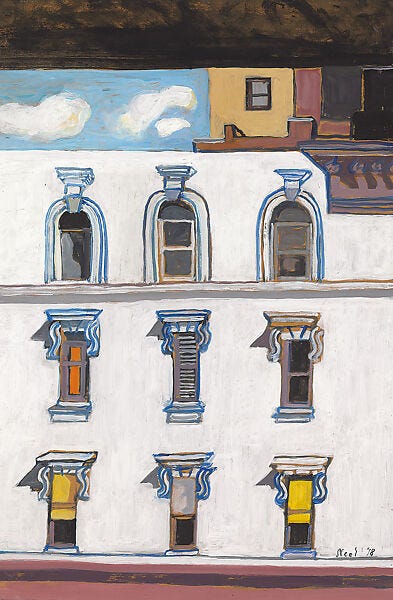
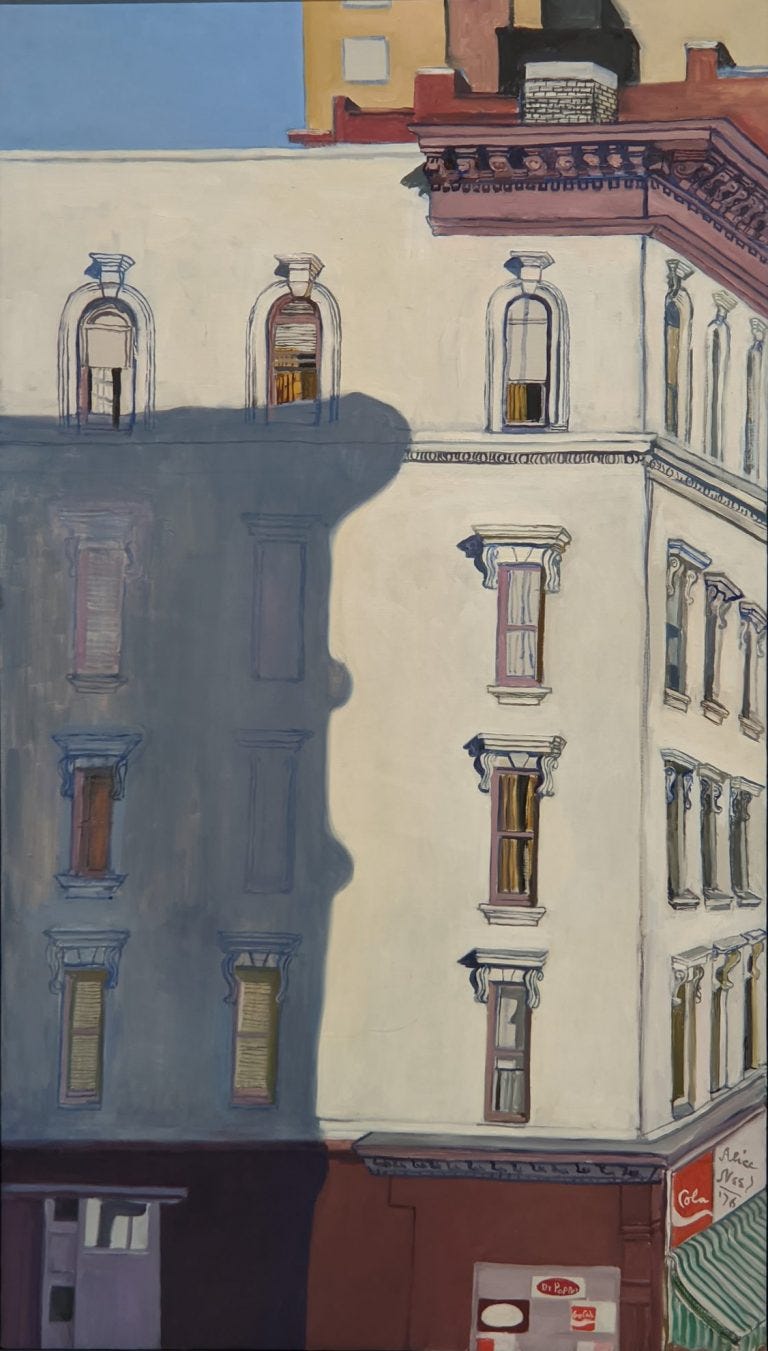
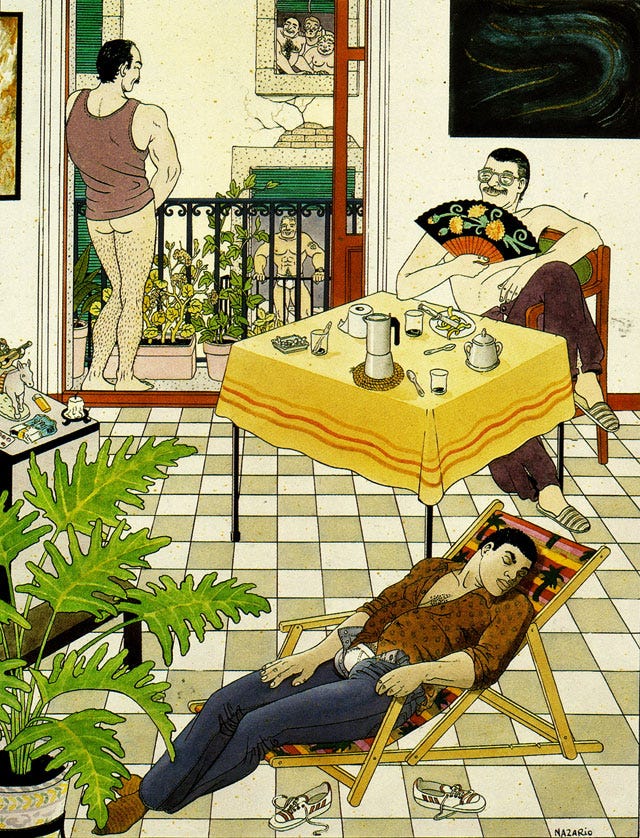
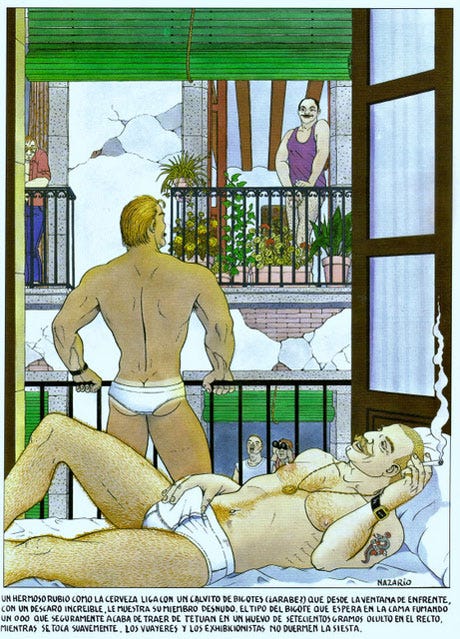
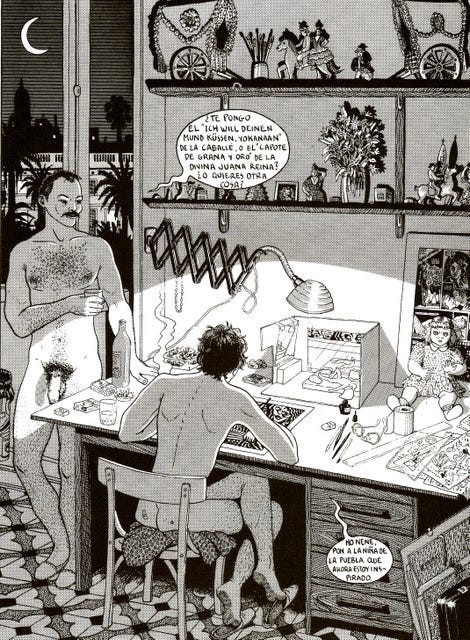
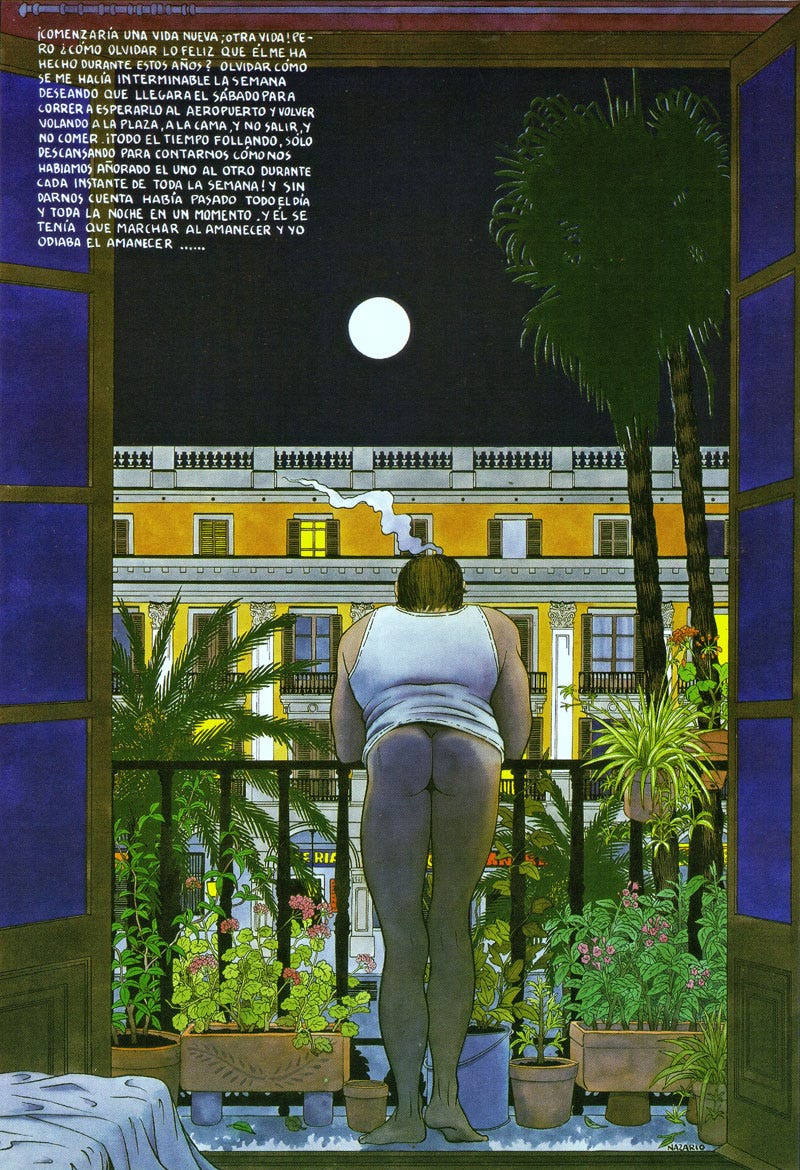
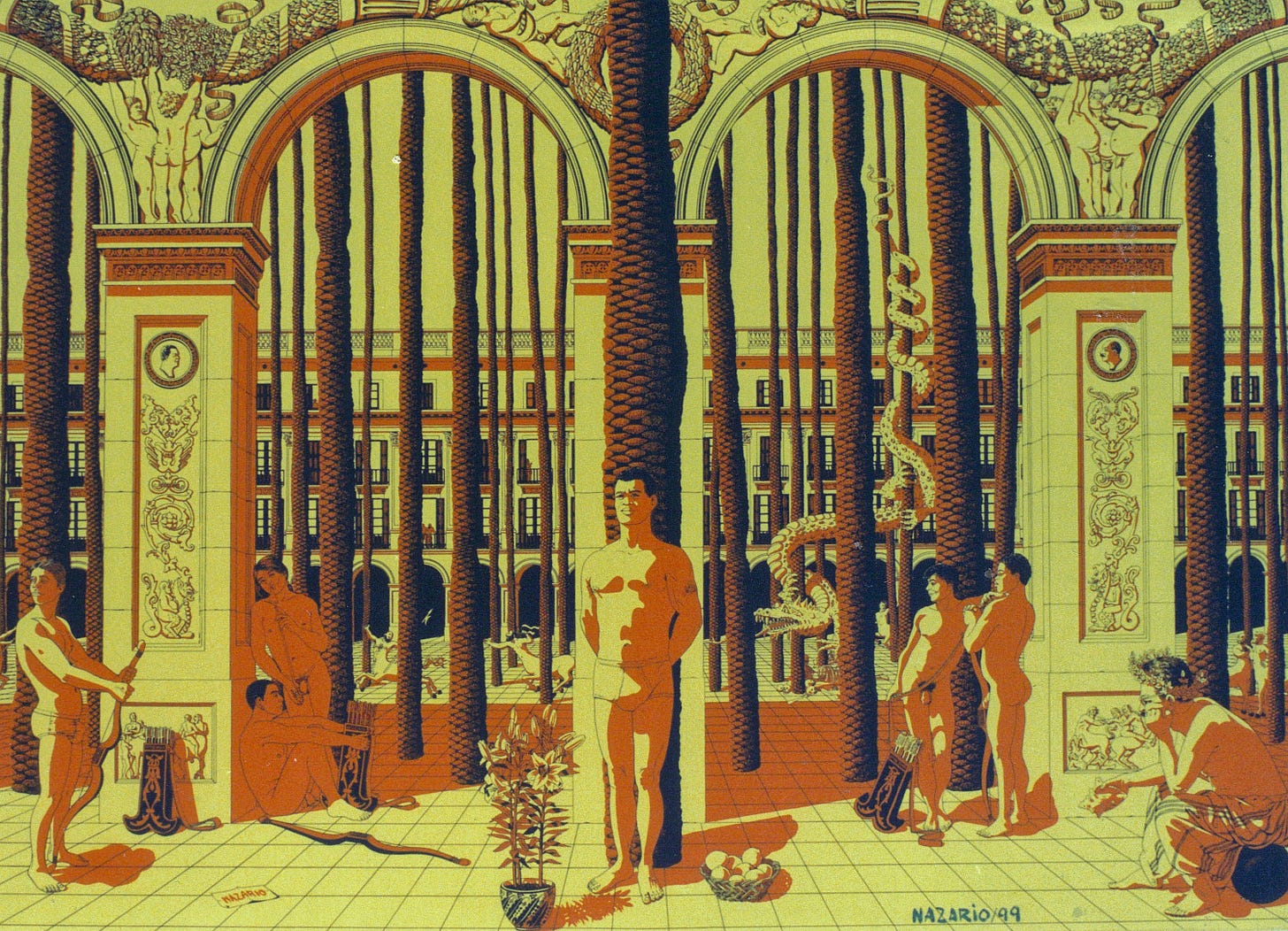

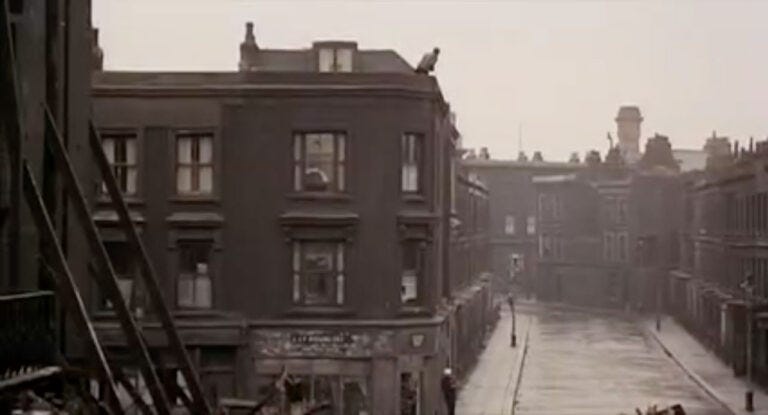
Wow, I can’t imagine anything I needed to read more in this exact moment. Thank you.
Beautifully written